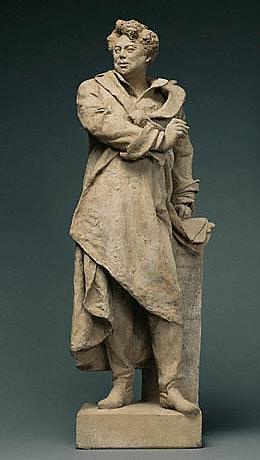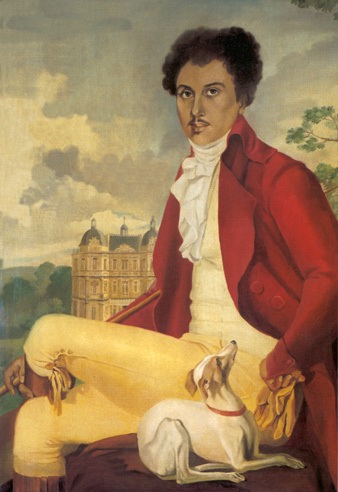|

Model for a monument to
Alexandre
Dumas père, about 1883, terracotta from Getty
Foundation |
On
1 February 1840 he married an actress, Ida Ferrier, born Marguerite-Joséphine
Ferrand (1811—1859) but continued with his numerous liaisons with other women,
fathering at least four illegitimate children. One of those children, a son
named after him, whose mother was Marie-Laure-Catherine Labay (1794—1868), a
dressmaker, would follow in his footsteps, also becoming a successful novelist
and playwright. Because of their same name and occupation, to distinguish them,
one is referred to as Alexandre Dumas, père, the other as Alexandre Dumas, fils.
His three other children were: 1) Marie-Alexandrine Dumas (5 March 1831—1878)
who later married Pierre Petel and was daughter of Belle Krelsamer
(1803—1875), 2) Micaëlla-Clélie-Josepha-Élisabeth Cordier, born in 1860 and
daughter of Emélie Cordier, and 3) Henry Bauer, born of an unknown mother.
Dumas
made extensive use of the aid of numerous assistants and collaborators, of which
Auguste Maquet was the best known. It was Maquet who outlined the plot of The
Count of Monte Cristo, and made substantial contributions to The Three
Musketeers and its sequels, as well as several of Dumas’ other novels. When
working together, Maquet proposed plots and wrote drafts, while Dumas added the
details, dialogues, and the final chapters. See Andrew Lang essay, Alexandre
Dumas - in his Essays In Little (1891) - for an accurate description of these
collaborations.
Dumas’
writing earned him a great deal of money; but Dumas was frequently broke or in
debt, as a result of spending lavishly on women and high living. The large and
costly Château de Montecristo that he built was often filled with strangers and
acquaintances, who took advantage of his generosity.
When
King Louis-Philippe was ousted in a revolt, Dumas was not looked upon
|
|
favorably
by the newly elected President, Louis-Napoléon Bonaparte. In 1851 Dumas fled to
Brussels, Belgium, to escape his creditors; and from there he traveled to
Russia, where French was the second language, and where his writings were
enormously popular. Dumas spent two years in Russia, before moving on to seek
adventure and fodder for more stories. In March 1861 the kingdom of Italy was
proclaimed, with Victor Emmanuel II as its king. For the next three years
Alexandre Dumas would be involved in the fight for a united Italy, founding and
leading a newspaper, named Indipendente, and returning to Paris in 1864.
Despite
Alexandre Dumas’ success and aristocratic connections, his being of mixed-race
would affect him all his life. In 1843 he wrote a short novel, Georges, which
addressed some of the issues of race and the effects of colonialism. He once
remarked to a man who insulted him about his mixed-race background:
“My
father was a mulatto, my grandfather was a Negro, and my great grandfather a
monkey. You see, Sir, my family starts where yours ends.”
In
June 2005 Dumas’ recently-discovered last novel, The Knight of Sainte-Hermine,
went on sale in France. Within the story Dumas describes the Battle of
Trafalgar, in which the death of Lord Nelson is explained. The novel was being
published serially and was almost complete at the time of his death. A final
two-and-a-half chapters were written by modern-day Dumas scholar Claude Schopp,
who based his efforts on Dumas’ pre-writing notes. |

